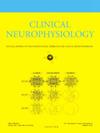Long-term motor learning in focal hand dystonia
IF 3.7
3区 医学
Q1 CLINICAL NEUROLOGY
引用次数: 0
Abstract
Objective
Because focal hand dystonia usually occurs in the over-learned stage, it would be valuable to know long-term motor learning characteristics and underlying pathophysiological features that might predispose to dystonia.
Methods
We conducted a case-control exploratory study of 15 visits over 12 weeks in the non-affected hand of a 4-finger sequence of 8 key presses in eight patients with FHD compared with eight age- and sex-matched, healthy volunteers (HVs). We studied the behavioral data and the physiological changes of the brain, including motor cortical excitability and cortical oscillations.
Results
There was no significant difference in the time to reach 100 % accuracy between FHD and HV during the 80-day follow-up period. There was a statistically significant difference in the accuracy of sequential finger movement tasks between patients with FHD compared with HVs over 12 weeks, but post-hoc analysis with multiple comparion correction did not show difference. There were no significant differences in recruitment curve changes and task-related power changes of alpha and beta bands.
Conclusion
Over 12 weeks, FHD have motor learning capacity comparable to HVs and do not show pathophysiological abnormalities.
Significance
Further studies would be valuable with more patients, more extended periods of practice, and more detailed electrophysiological explorations.
局灶性手部肌张力障碍的长期运动学习
目的由于局灶性手肌张力障碍通常发生在过度学习阶段,因此了解长期的运动学习特征以及可能导致肌张力障碍的潜在病理生理特点非常有价值。方法我们对8名FHD患者与8名年龄和性别匹配的健康志愿者(HVs)进行了一项病例对照探索性研究,在12周内对8个按键的4指序列进行了15次访问。我们研究了行为数据和大脑的生理变化,包括运动皮层兴奋性和皮层振荡。结果在 80 天的随访期间,FHD 和 HV 达到 100 % 准确率的时间没有显著差异。在12周内,FHD患者与HV患者在连续手指运动任务的准确性上存在显著统计学差异,但经多重比较校正的事后分析未显示出差异。结论在 12 周内,FHD 患者的运动学习能力与 HVs 相当,且未出现病理生理异常。
本文章由计算机程序翻译,如有差异,请以英文原文为准。
求助全文
约1分钟内获得全文
求助全文
来源期刊

Clinical Neurophysiology
医学-临床神经学
CiteScore
8.70
自引率
6.40%
发文量
932
审稿时长
59 days
期刊介绍:
As of January 1999, The journal Electroencephalography and Clinical Neurophysiology, and its two sections Electromyography and Motor Control and Evoked Potentials have amalgamated to become this journal - Clinical Neurophysiology.
Clinical Neurophysiology is the official journal of the International Federation of Clinical Neurophysiology, the Brazilian Society of Clinical Neurophysiology, the Czech Society of Clinical Neurophysiology, the Italian Clinical Neurophysiology Society and the International Society of Intraoperative Neurophysiology.The journal is dedicated to fostering research and disseminating information on all aspects of both normal and abnormal functioning of the nervous system. The key aim of the publication is to disseminate scholarly reports on the pathophysiology underlying diseases of the central and peripheral nervous system of human patients. Clinical trials that use neurophysiological measures to document change are encouraged, as are manuscripts reporting data on integrated neuroimaging of central nervous function including, but not limited to, functional MRI, MEG, EEG, PET and other neuroimaging modalities.
 求助内容:
求助内容: 应助结果提醒方式:
应助结果提醒方式:


